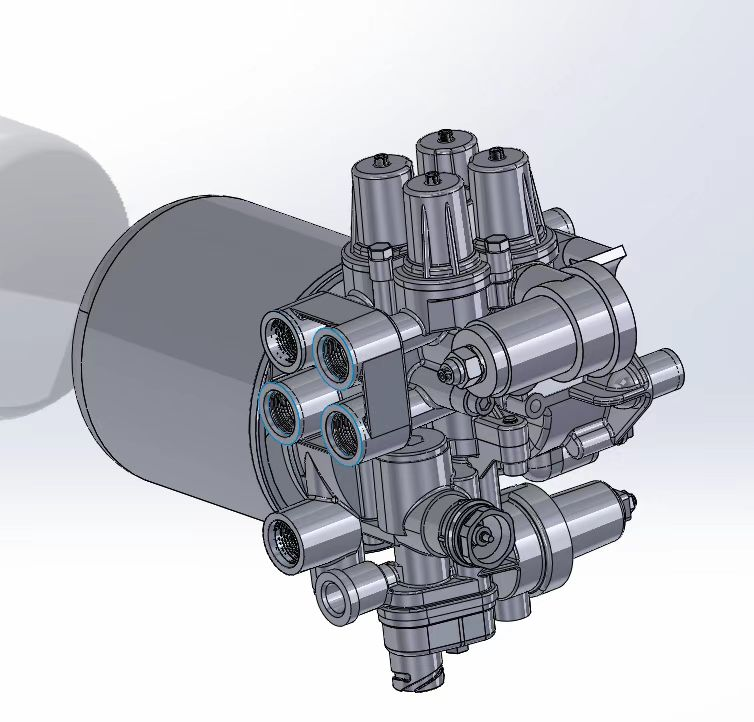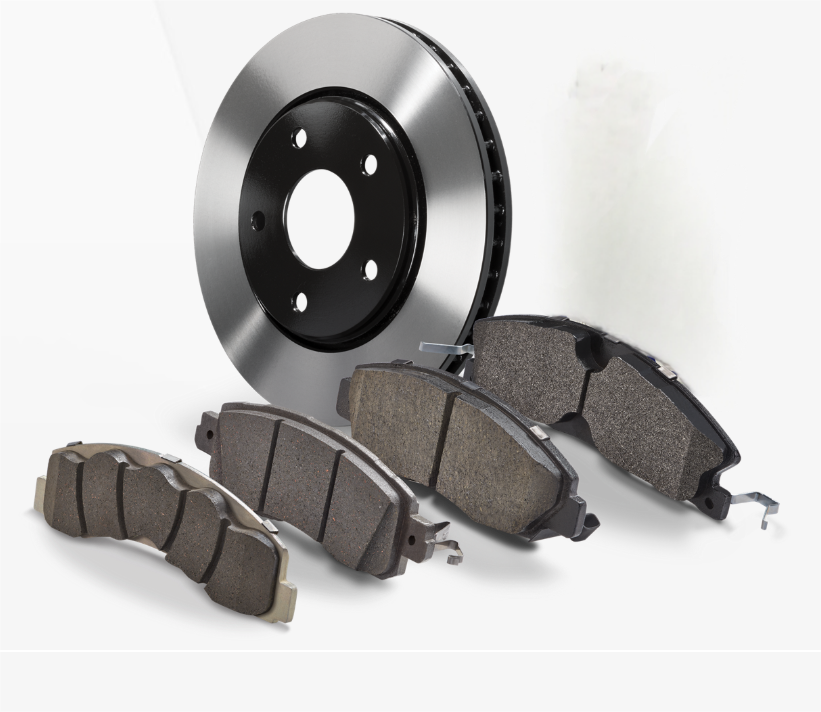Understanding Truck Brake System Components
The safety of transporting goods across long distances depends heavily on properly functioning brake systems in commercial trucks. Brake pads, rotors, drums, and calipers make up the core elements needed for reliable stopping power and vehicle control during operation. When a driver hits the brakes, the pads actually transform motion into heat through friction, slowing down the massive weight behind them. Rotors and drums serve as the contact points where this friction occurs, creating the necessary resistance to bring vehicles to a halt. Calipers clamp those pads against the spinning surfaces, applying force when needed. All these parts must work together seamlessly so that big rigs can come to a complete stop safely, no matter how much cargo they're carrying on board.
Looking at air brakes compared to hydraulic ones, there's definitely a difference in how they work and where they're applied. Most big rigs run on air brakes since they need all that stopping power. These systems push brake pads using compressed air. Hydraulic systems work differently though they still stop vehicles but through pressurized fluid instead. Trucking groups have done some research on this stuff too. Their findings suggest that parts in air brake systems such as compressors and those air tanks tend to last around 3 to 5 years give or take. But hydraulic components can be all over the map depending on how much someone drives and whether regular maintenance gets done properly or not.
Quality truck fuel pumps play a critical role in keeping the whole braking system working properly. When a driver hits the brakes hard, especially during emergencies, the engine needs enough fuel to keep running smoothly through those moments of stress. Without a good fuel pump, things can go south fast. Mechanics know this all too well from their shop experiences. That's why regular checkups matter so much. Most experts recommend looking at fuel pumps every 50,000 miles or so, depending on how tough the driving conditions get. Replacing them before they fail isn't just about avoiding breakdowns it's about making sure drivers stay safe on long hauls where getting stranded somewhere remote could be dangerous.
How Drum Brakes and Air Disc Brakes Differ
Knowing what sets drum brakes apart from air disc brakes makes all the difference when it comes to keeping truck brake systems running smoothly. With drum brakes, the basic idea is simple enough - friction happens when those brake shoes rub against the metal drum to slow things down. Air disc brakes work differently though, using pads that clamp onto a spinning rotor instead. Drum brakes have their perks too. They tend to last longer under tough conditions and can handle serious weight loads, which explains why so many long haul trucks still rely on them. The catch? These same drum brakes need regular tweaking and checkups if they're going to perform reliably over time. Mechanics will tell anyone who'll listen that neglecting these adjustments can lead to bigger problems down the road.
Air disc brakes get a lot of praise when it comes to how well they stop vehicles and handle heat buildup during operation. These systems generally offer much shorter stopping distances than traditional drum brakes, which makes them safer in emergency situations. Maintenance tends to be easier too since there are just not as many components involved in the braking process. The downside? Air disc brakes typically come with a bigger price tag upfront. Plus, getting them fixed often means finding someone with specific training and equipment, which can add to long term expenses for fleet operators looking at multiple units.
Studies comparing the braking efficiency and stopping distances reveal that air disc brakes can reduce stopping distances by upwards of 30% compared to drum brakes. Despite this advantage, drum brakes remain popular in certain sectors due to their cost-effectiveness and reliability under continuous heavy-duty usage.
Essential Brake Inspection Procedures
How to Check Brake Linings and Pads for Wear
Checking brake linings and pads remains a critical part of keeping trucks safe on the road. Technicians typically start with a thorough visual inspection combined with some hands-on testing. They watch out for signs of uneven wear patterns across the surface area and measure how thick the material has become over time according to manufacturer specs. Most maintenance guides recommend that commercial vehicle brake pads shouldn't drop below roughly quarter inch thickness before replacement becomes necessary. These routine checks serve multiple purposes beyond just meeting safety requirements. Catching issues early through regular maintenance saves money in the long run by avoiding major breakdowns and keeps the braking system performing at its best when it matters most.
Testing Slack Adjuster Functionality
Checking how well slack adjusters work remains essential when maintaining brakes. Here's what needs doing: First off, look at the adjustment angle and make sure everything lines up properly. Then go ahead and physically inspect those adjusters for signs of wear. If they're not synchronized, problems will follow pretty quickly. According to industry reports, poorly adjusted slack adjusters can really cut down on braking power, which means longer stops and higher chances of accidents happening. Regular inspections keep these components functioning correctly, cutting down on safety issues before they become major concerns. For mechanics and vehicle owners alike, staying on top of this maintenance task isn't just recommended it's absolutely necessary for road safety.
Air System Leak Detection Methods
Finding air leaks in brake systems isn't hard if mechanics know where to look. Most shops start by simply listening closely for hissing sounds around fittings and valves. Another common approach involves spraying soapy water onto suspected areas while pressurized - bubbles will form wherever there's an escape point. Pressure gauge readings taken at different points in the system also reveal inconsistencies that might indicate problems. Mechanics generally suggest checking for leaks monthly as part of standard maintenance routines, though some facilities do it more frequently depending on usage patterns. These periodic inspections keep everything running smoothly, prevent sudden failures from hidden leaks, and ultimately save money by catching small issues before they become major repairs down the road.
Preventing Common Brake System Failures
Avoiding Overheating in Downhill Braking
Keeping brakes from getting too hot when going down long hills is really important for safe driving. Most experienced truckers know this trick works best: use engine braking instead of relying solely on foot brakes all the time. When we look at what happens on the road, many brake failures actually come from excessive heat buildup, especially those big rigs traveling through mountain passes. Real world data shows something similar too. What makes sense here? Shift into a lower gear early on steep grades and keep an eye on those brake temps regularly. This approach cuts down on heat accumulation and keeps everyone safer out there on the highways.
Recognizing Signs of Wheel End Damage
Finding problems with wheel ends before they get bad is really important for keeping trucks safe on the road. Drivers need to watch out for things like tires wearing down unevenly or seeing oil coming from bearings. They also hear warning signs sometimes - strange vibrations while driving or that awful grinding noise when turning. The numbers don't lie either; plenty of crash investigations point back to poor wheel end care as a major factor. Truck operators who skip these checks put everyone at risk. Regular looks under the hood (and wheels) plus fixing issues as soon as possible saves money in the long run and keeps drivers off the side of the highway with broken down rigs.
Interpreting ABS and Low-Pressure Warnings
Knowing what those ABS (Anti-lock Braking System) warnings mean along with low pressure alerts really matters when it comes to keeping brakes working properly. When the ABS light goes on, it basically means there's something wrong with how the system stops wheels from locking up during hard braking, which could make driving dangerous. Low pressure warnings are even scarier because they point toward possible brake failure down the road. If either of these lights come on, drivers need to check right away for things like fluid leaks or faulty sensors. Mechanics always stress doing regular inspections too, since catching problems early saves money and prevents accidents later on. Most people don't realize just how critical these little dashboard indicators actually are until they're stuck somewhere without proper stopping power.
Maintenance Strategies for Optimal Brake Performance
Routine Service Intervals for Heavy-Duty Components
Setting up regular checkups for brake parts makes all the difference when it comes to keeping those big rigs safe and running properly. Most mechanics will tell drivers to look at their brake pads somewhere around 20k to 30k miles mark, but this really depends on how hard the truck works day after day. Rotors and drums need attention too, so getting them checked out roughly every 50k miles catches problems before they become major headaches. Sticking to these service times according to what the industry says best practice helps keep brakes working when they matter most. When truck owners actually follow through with proper maintenance schedules, they're doing more than just ticking boxes for compliance. They're literally preventing situations where worn out brakes fail while driving down highway at 65mph, which nobody wants to experience firsthand.
Best Practices for Air Dryer Maintenance
Air dryers are absolutely necessary for keeping truck brakes working properly since they stop all sorts of problems caused by moisture buildup. Mechanics generally recommend swapping out the desiccant cartridge in the air dryer around every 100k miles mark or once per year, whichever comes first, to keep things running smoothly. The whole air supply system needs regular checks too because even small leaks can create big headaches down the road. When folks skip routine air dryer maintenance, moisture tends to accumulate inside the system which eventually eats away at brake linings and makes stopping distances longer than they should be. Following standard maintenance protocols helps avoid these kinds of troubles while making sure those heavy haulers stop reliably when needed most.
When to Replace Brake Rotors and Drums
Knowing when it's time to swap out brake rotors and drums makes all the difference in keeping brakes working properly and safely. Most mechanics recommend replacing rotors when they get thinner than what the car maker specifies, especially if they show signs of warping or deep grooves from constant use. Same goes for brake drums which need replacing when they wear down too much or develop scoring along their surface. For heavy duty trucks doing regular hauling work, we generally see rotors lasting between 50k and 70k miles before needing attention, though this varies quite a bit based on road conditions and how often the driver uses the brakes hard. Monitoring these wear indicators isn't just good practice it's actually critical safety stuff. Delaying replacements can lead to serious problems down the road, so staying on top of brake component health should be part of every routine maintenance schedule.
Preparing for Brake Safety Week Inspections
Documentation Requirements for Compliance
Getting prepared for Brake Safety Week checks means making sure all the right papers are in order. To stay compliant, operators need to maintain records on maintenance work done, track service history, plus keep those compliance checklists updated as proof of regular vehicle maintenance. Regulatory agencies actually stress that these records should be spot on and up to date. Take it from the folks at CVSA who point out that good documentation shows real dedication to both safety standards and proper maintenance practices. Don't forget to file away records covering brake inspections, repair jobs, and when parts got swapped out. When inspectors come knocking, having everything organized makes their job easier and builds trust about how well those critical braking systems have been maintained over time.
Pre-Trip Checklist for Brake Systems
A good pre-trip checklist helps keep those brakes working properly when it matters most. When putting together this list, don't forget to check things like brake pads, rotors, drums, plus that air dryer system too. Regular maintenance catches problems early before they turn into roadside emergencies. According to what many in the trucking world have found, sticking to routine inspections cuts down brake failure chances quite a bit, which means safer driving and better overall performance. Taking time to go through each part of the braking system before hitting the highway ensures those critical components stay reliable for long hauls. This kind of preparation keeps operations running smoothly while meeting all necessary safety requirements as well.
Understanding CVSA Inspection Criteria
Knowing what the CVSA looks for during inspections makes all the difference when it comes to staying compliant during Brake Safety Week. The organization has established clear guidelines covering everything from brake parts to air systems and general vehicle condition. Failing to follow these rules doesn't just cost money through hefty fines, it can also result in vehicles being taken off the road entirely. Real world examples show that trucks failing inspections often face delays and increased operating costs. Drivers need to check their brakes regularly against these standards because avoiding tickets isn't the only reason. Safe roads depend on properly functioning equipment too. Familiarity with CVSA requirements helps fleets stay ready for roadside checks and keeps them aligned with current best practices in commercial transportation safety.







